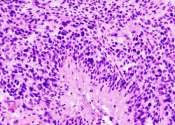Here's how cancer hijacks wound healing to create its own blood supply
Researchers at the University of Virginia School of Medicine have shed light on how cancers hijack the body's natural wound-healing response to grow and spread.
May 1, 2019
0
0
Researchers at the University of Virginia School of Medicine have shed light on how cancers hijack the body's natural wound-healing response to grow and spread.
May 1, 2019
0
0

Once the heart is fully formed, the cells that make up heart muscle, known as cardiomyocytes, have very limited ability to reproduce themselves. After a heart attack, cardiomyocytes die off; unable to make new ones, the heart ...
Apr 22, 2019
0
67

A study by University of North Carolina Lineberger Comprehensive Cancer Center researchers helps explain how tumors recruit blood vessels that provide fuel for their growth as well as an avenue for the tumors to spread.
Apr 19, 2019
0
20

Relapse of disease following conventional treatments remains one of the central problems in cancer management, yet few therapeutic agents targeting drug resistance and tolerance exist. New research conducted at the Cancer ...
Apr 8, 2019
0
91

Postoperative liver dysfunction (failure) is the most serious complication that can occur following liver resection (full or partial hepatectomy) to remove liver tumours. Hitherto, the only tests available for preoperative ...
Mar 18, 2019
0
4

Researchers at TIFR have discovered molecular anticipation of feeding in the liver that is essential to ensure that the body, after fasting, adapts to use incoming nutrients upon re-feeding. Their findings, published in the ...
Feb 20, 2019
0
0

In cancer therapeutics research, microRNAs—tiny strings of nucleotides that get churned out inside cells—have been a source of both excitement and disappointment. While preclinical studies have found that microRNAs play ...
Jan 25, 2019
0
39

Monash University engineers have unlocked the door to earlier detection of cancer with a world-first study identifying a potential new testing method that could save millions of lives.
Jan 4, 2019
0
5

Small RNA molecules in saliva could be used to detect the virus that causes hand, foot and mouth disease, enabling early intervention to limit spread of the infection.
Dec 20, 2018
0
1

The recent discovery of microRNAs as key regulators of biological processes has fueled an explosion of research activity into their function in health and disease. Researchers have now uncovered a microRNA cluster that regulates ...
Dec 17, 2018
0
57
